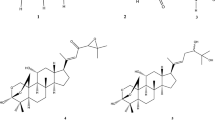Abstract
The structure of 2,7-dibromocryptolepine acetic acid solvate, C16H11N2Br2 [1.5(C2H4O2)][C2H3O −2 ][0.5H2O], Mr = 460.17, has been determined from X-ray diffraction data. The crystals are monoclinic, space group P21/c with Z = 4 molecules per unit cell and a = 7.3243(3), b = 18.7804(6), c = 15.8306(7) Å, β = 94.279(1)°, Vc = 2171.5(2) Å, crystal density Dc = 1.667 g/cm3. The structure was determined using direct methods and refined by full-matrix least-squares to a conventional R-index of 0.0496 for 4,908 reflections and 258 parameters. The cryptolepine nucleus of the 2,7-dibromocryptolepine molecule is highly planar and the two Br atoms are in this plane within 0.06 and 0.01 Å, respectively. The crystal structure is maintained via hydrogen bonding between N(10) in the cryptolepine nucleus and the oxygen of one of the three solvated acetic acid molecules. The acetic acid molecules also form hydrogen bonded chains. Acetic acid B is deprotonated and its two C–O bond lengths are equivalent, unlike those in A and C. Acetic acid C lies very close to a crystallographic centre of symmetry. To avoid overlap the two repeats cannot exist together and are subject to 50% statistical disorder. O(1C) of this methanol is furthest from the two-fold axis and its occupancy refines to a value of 1.0 and is assumed to exist alternately as a water oxygen hydrogen bonding to methanol O(1C) across the two-fold axis at a distance of 2.775 Å.
Index Abstract
The antiplasmodial activity of the analogue 2,7-dibromocryptolepine is nine times greater than that of cryptolepine itself against chloroquine-resistant Plasmodium falciparum (multi-drug resistant strain K1) with IC50 values = 0.44 and 0.049 μM, respectively. This analogue also showed promising in vivo activity against P. berghei in mice. Parasitaemia was suppressed by 91.4% compared to untreated infected control animals at a dose of 25 mg/kg given daily by i.p. injection with no apparent toxicity to the mice, in contrast to cryptolepine which was toxic to mice when given i.p. at 20 mg/kg. Further experiments showed a dose-dependent relationship with ED50 and ED90 values of 6.92 and 21.46 mg/kg/day, respectively. Although 2,7-dibromocryptolepine was not toxic to the mice its cytotoxic activity is similar to that of cryptolepine, but unlike cryptolepine it does not appear to intercalate into DNA as assessed using thermodenaturation techniques (ΔTm values = 3 and 9 °C, respectively). Like cryptolepine, 2,7-dibromocryptolepine inhibits the formation of haemozoin, but its increased antiplasmodial potency does not appear to be due to more potent inhibition of haemozoin formation, nor to increased accumulation into the acidic parasite food vacuole suggesting that 2,7-dibromocryptolepine has additional modes of action compared to cryptolepine. The X-ray structure of this compound will help to determine whether or not 2,7-dibromocryptolepine is able to intercalate into DNA and facilitate the design of new cryptolepine analogues with DNA binding properties appropriate for antimalarial (with no DNA intercalation) or anticancer (sequence-specific binding) applications.





Similar content being viewed by others
References
Wright CW, Addae-Kyereme J, Breen AG, Brown JE, Cox MF, Croft SL, Gokcek Y, Kendrick H, Phillips RM, Pollet PL (2001) J Med Chem 44:3187
Bonjean K, De Pauw-Gillet MC, Defrense MP, Colson P, Houssier C, Dassonneville L, Bailly C, Greimers R, Wright CW, Quentin-Leclercq J, Tits M, Angenot L (1998) Biochemistry 37:5136
Onyeibor O, Croft SL, Dodson HI, Feiz-Haddad M, Kendrick H, Millington NJ, Parapini S, Phillips RM, Seville S, Shnyder SD, Taramelli D, Wright CW (2005) J Med Chem 48:2701
Lisgarten JN, Coll M, Portugal J, Wright CW, Aymami J (2002) Nat Struct Biol 9:57
Hooft R, Nonius BV (1998) COLLECT: X-ray data collection and processing software user interface
Cosier J, Glazer AM (1986) J Appl Cryst 19:105
Oxford Molecular (1999) http://www.oxmol.com:Chem-X
Otwinowski Z, Minor W (1997) Methods in enzymology. In: Carter CW Jr, Sweet RM (eds) Macromolecular crystallography Part A, vol 276. Academic Press, NY, pp 307–326
Blessing RH (1995) Acta Cryst A51:33
Blessing RH (1997) J Appl Cryst 30:421
Sheldrick GM (1986) SHELX86, program for crystal structure determination. University of Göttingen, Germany
Sheldrick GM (1997) SHELXL97, program for crystal structure refinement. University of Göttingen, Germany
Farrugia LJ (1999) J Appl Crystallogr 1999:837
Farrugia LJ (1997) J Appl Cryst 30:565 (based on ORTEP-III (v 1.0.3) by Johnson CK, Burnett MN)
Merrit EA, Bacon DJ (1997) Meth Enzymol 277:505 (Implemented in WinGX (qv) and generated by Ortep-3 for Windows)
Macrae CF, Edgington PR, McCabe P, Pidcock E, Shields GP, Taylor R, Towler M, van de Streek J (2006) J Appl Cryst 39:453
Wright CW, Philipson JD, Lisgarten JN, Palmer RA (1999) J Chem Cryst 29:449
Lisgarten JN, Potter BS, Palmer RA, Pitts JE, Wright CW (2008) J Chem Cryst. doi:10.1007/s10870-008-9397-8
Sayle R (1994) RASMOL, a molecular visualisation program. Glaxo Research and Development, UK
Author information
Authors and Affiliations
Corresponding author
Rights and permissions
About this article
Cite this article
Potter, B.S., Lisgarten, J.N., Pitts, J.E. et al. X-ray Crystallographic Structure of the Potent Antiplasmodial Compound 2,7-Dibromocryptolepine Acetic Acid Solvate. J Chem Crystallogr 38, 821–825 (2008). https://doi.org/10.1007/s10870-008-9398-7
Received:
Accepted:
Published:
Issue Date:
DOI: https://doi.org/10.1007/s10870-008-9398-7




